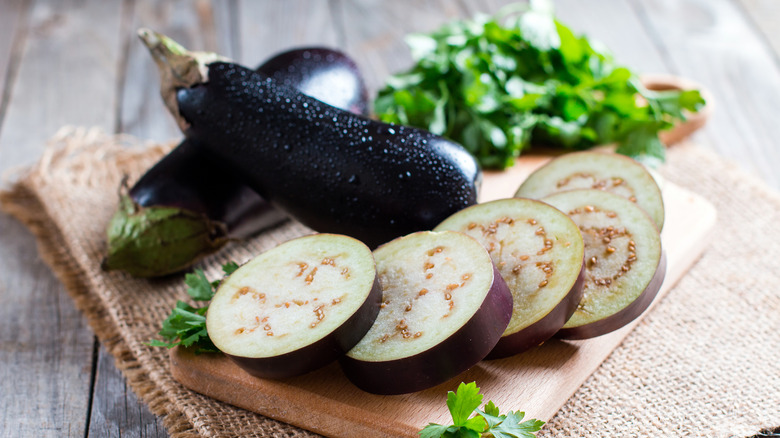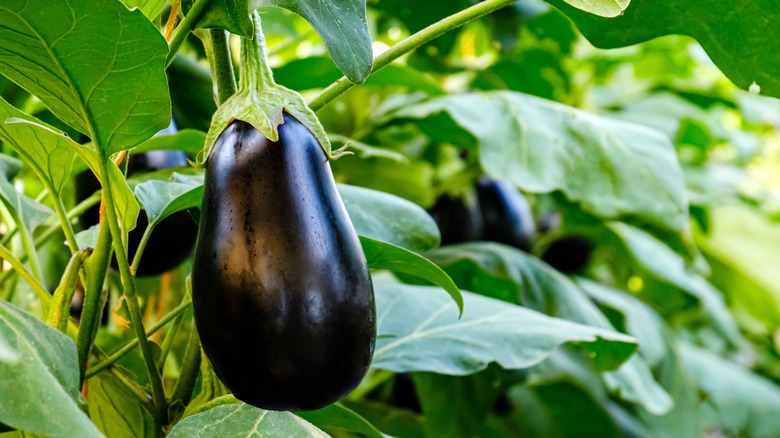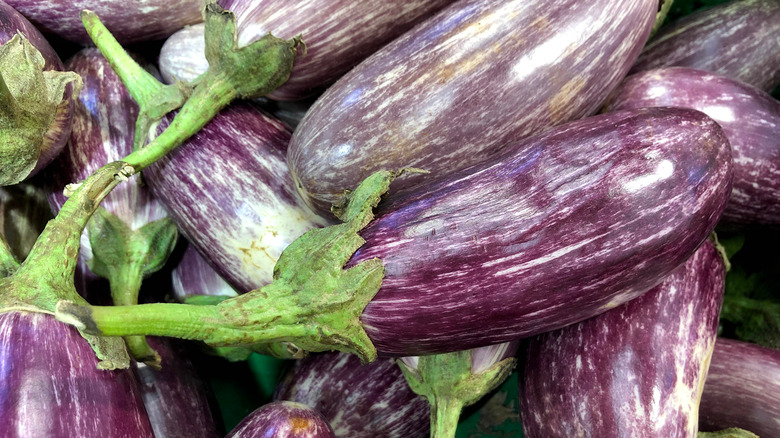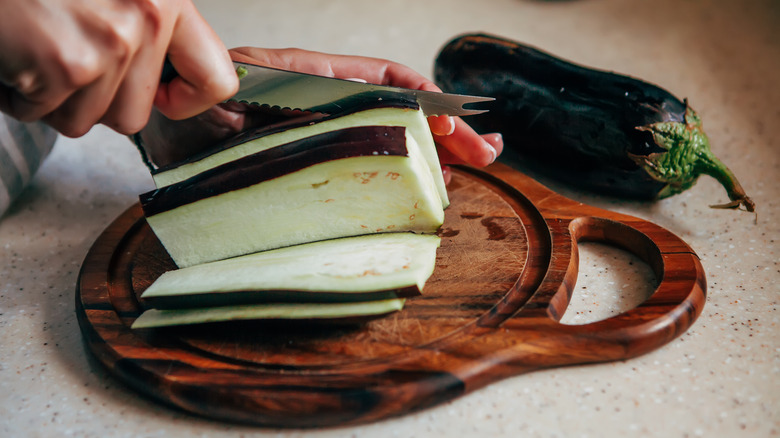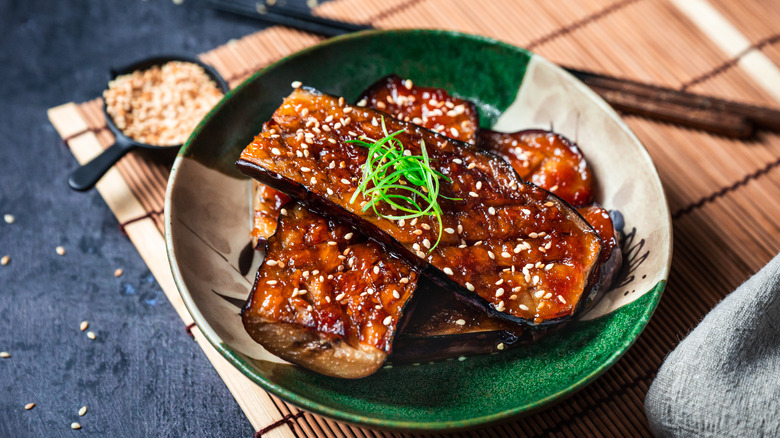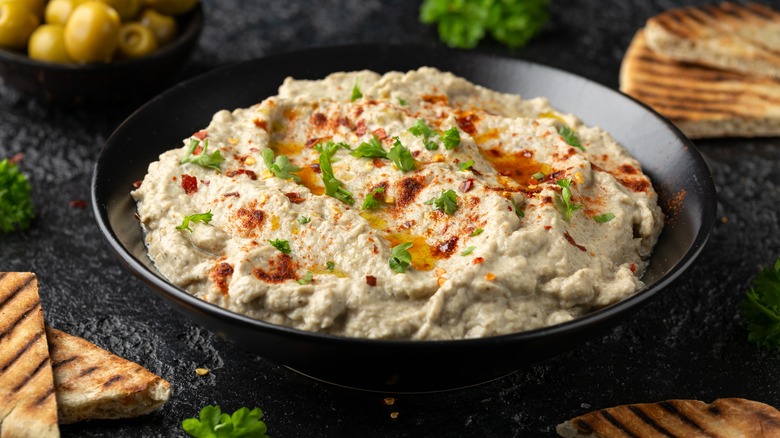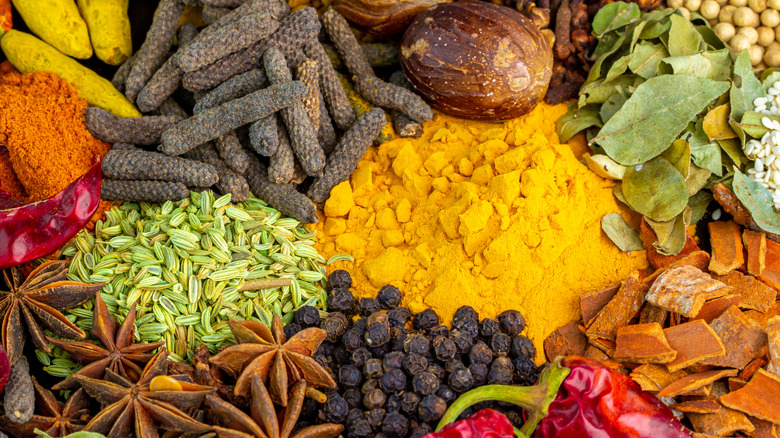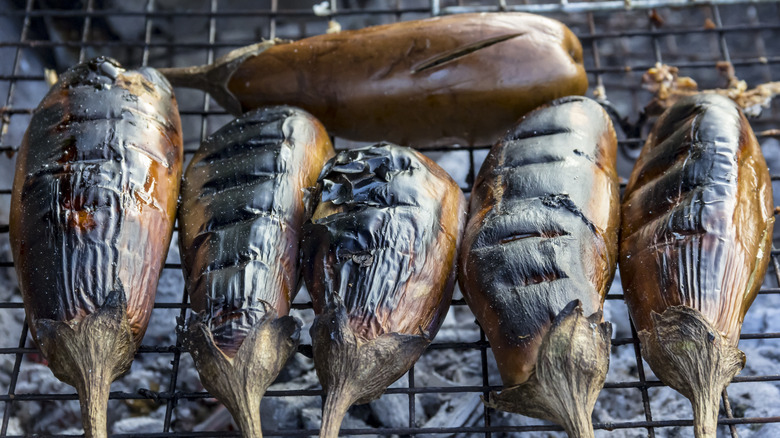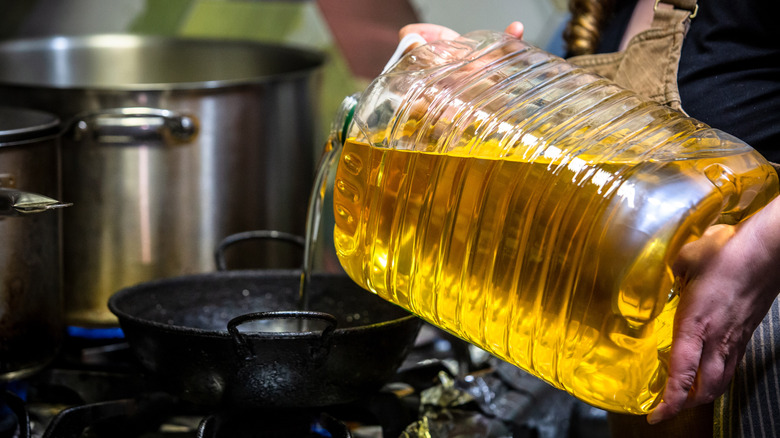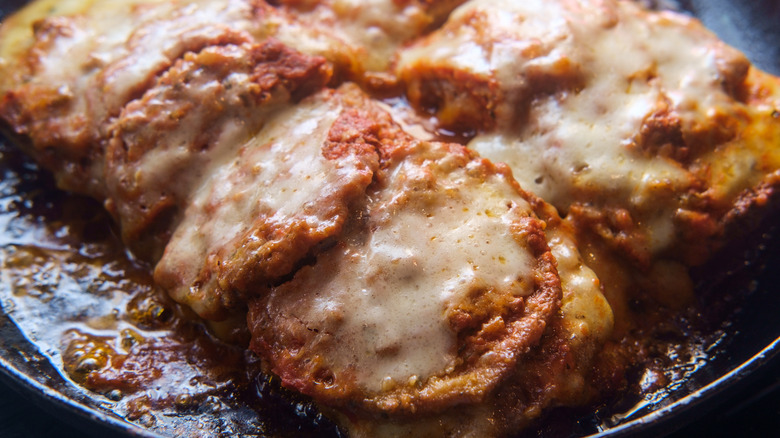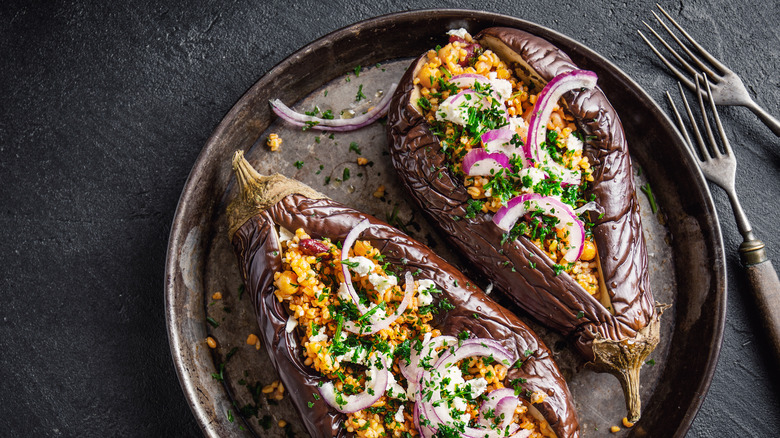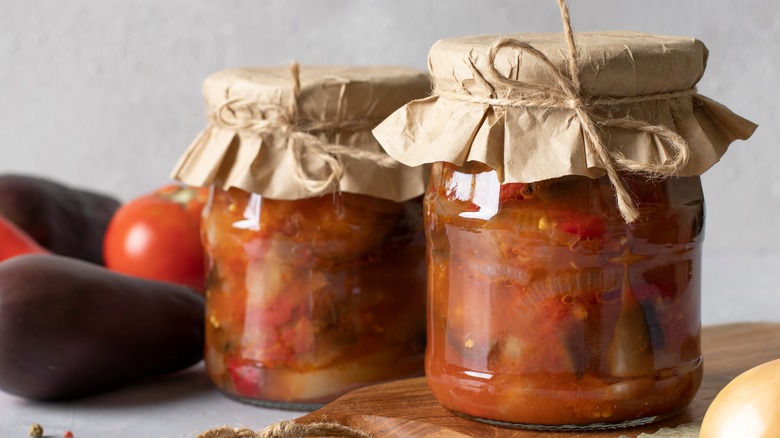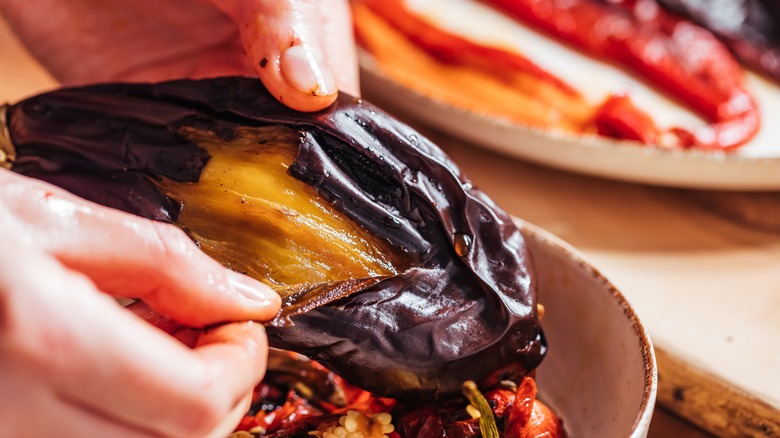13 Tips You Need When Cooking With Eggplant
Eggplant is an incredibly versatile fruit and a beloved ingredient in households worldwide. Thanks to its meaty texture and mild flavor profile, its usage is limitless and can be applied to several different cuisines and dietary preferences. Unfortunately, many people shy away from cooking with it because they feel intimidated by the task. Without utilizing the proper technique, eggplant can have a bitter taste and mushy texture, which is not always the desired outcome.
Additionally, in recent years the entire nightshade family has developed a bad reputation for causing inflammation (thank you, Tom Brady) when they are indeed very nutritious and full of health benefits. According to Healthline, eggplants are rich in nutrients, high in antioxidants, and can reduce the risk of certain diseases. They can also take on an amazing depth of flavor when cooked properly and are a year-round staple in our kitchen. We're confident that if you follow the tips below, you'll perfect the art of cooking eggplant.
When to eat eggplant
Eggplants are grown as annual plants, with their peak season taking place from July through October, but can generally be enjoyed throughout the year. As a result of tropical origins, eggplants thrive in warm-weather climates across the globe and are sensitive to the cold (including the refrigerator).
Eggplants are ready for harvest once they fully develop in size and color and have firm, glossy skins. You'll know if an eggplant has over-matured and thus will have a bitter flavor because the skin will be marked with brown streaks (via SF Gate). Although eggplants are most commonly recognized as oval and purple, many varieties grow in abundant shapes and colors.
If you wonder which state grows more eggplant than any other in the U.S., the answer may surprise you. It turns out New Jersey holds that title (it is the Garden State, after all), and according to the Daily Record, South Jersey is particularly proficient thanks to its well-drained, sandy-loam soil, which helps the species to thrive.
Choose the right eggplant variety
One of the unique characteristics of eggplants is that there are so many different varieties to choose from and cook with, depending on the specific culinary application. For example, Globe eggplants are quite large and can be sliced into thick rounds for Eggplant Parmesan, whereas Japanese and Chinese eggplants are long and slender, which work great for dishes like Szechuan stir fry. To find the best variety, we recommend visiting your local farmer's market during the summer months to peruse the stands and try some lesser-known types, such as fairytale eggplants, named for their miniature size and whimsical appearance.
No matter which variety you choose, eggplants can be cooked using both dry and moist heat methods, determined by whether or not a food item is cooked directly in liquid, and needs to be covered by a lid, including grilling, sauteing, steaming, roasting, and braising. Each variety yields a slightly different flavor, so it's always best to do your research ahead of time, whether online or speaking directly with a farmer, to pick the best eggplant for your specific dish.
Bigger isn't always better
Similar to choosing a specific eggplant variety, you must decide which size to use. This can vary greatly from ounces to pounds, but larger eggplants generally contain more seeds, resulting in a bitter taste — this is why it's generally a good idea to buy small eggplant. Harvesting them at the peak moment is important because they continue growing larger as they mature. Along with size, you also want to test the skin for color and firmness when you're selecting the perfect eggplant. If you press a finger on the eggplant and don't meet any resistance, you will likely end up with a mushy product.
Smaller eggplants are quite versatile and have a more concentrated flavor profile. That being said, larger-sized eggplants can serve a purpose and are beneficial in certain applications, especially whole-roasted, as long as you season them properly. When shopping at the store or your local farmer's market, look for smooth and shiny eggplants with vibrant colors that produce a sweeter flavor.
Salt the eggplant
There is a lot of debate in the cooking world about cooking eggplant in oil and whether or not you need to salt your eggplant. Some say the latter is no longer necessary as the modern varietals are bred to be less bitter. Others tout its importance when working with larger eggplants, such as the Italian variety, as it reduces the moisture content, yielding a crispier texture. No matter where you stand on the issue, salting is a tried-and-true method that has been around for many years. It helps offset bitterness and prevents a rubbery end product.
If you have the time, it's always good practice to salt your eggplants, as this helps ensure an even amount of seasoning throughout your dish. The best way to do so is by cutting your eggplant into the desired shape (planks, rounds, etc.) and laying them flat on a paper-towel-lined surface. Salt generously and cover with another layer of paper towels to help absorb any excess moisture. Let sit for anywhere from 10 to 30 minutes; rinse off the excess salt, and pat the eggplant pieces dry before you start cooking.
Inject flavor into the eggplant
Eggplant is versatile, thanks partly to a neutral taste and absorbent, sponge-like properties. It acts as a blank canvas that can soak up a multitude of bold flavors and is featured across many global cuisines, including Italian, Middle Eastern, Japanese, Chinese, Indian, and more. For a stunning centerpiece dish, especially in place of meat, we recommend making crosshatch marks in the flesh with your knife that will help create a grilled or charred appearance – similar to chicken or steak.
When preparing an eggplant recipe, we suggest marinating the eggplant either before or after the cooking process to enhance the depth of flavor further. If you marinate ahead of time, the ingredients can penetrate the eggplant flesh through the crosshatch marks. Another method is to cook your eggplant first (typically on the grill), and once cooled, transfer it to the marinade for about 6 to 12 hours and serve at room temperature as part of an antipasto dish.
Consider the texture you're looking to achieve
As we've mentioned, the humble eggplant can take on many different forms, so it's important to know which route you're taking. You can utilize varying cooking methods to yield certain textures, whether crispy, chewy, creamy, or otherwise. For example, roasting whole eggplants in the oven creates a custardy, smooth texture for spreadable dishes like baba ganoush. In this application, you can roast the eggplant in your oven, on the stovetop over an open flame, or over a bed of charcoal to impart a delicate, smoky flavor to the ingredient. Because the skin is so firm, the outside of the eggplant gets lightly charred while the inside steams and breaks down the flesh.
Alternatively, fried or grilled eggplant will produce firmer pieces that maintain their structure and can be substituted for meat in many vegetarian, vegan, and plant-based dishes. You can also braise or saute eggplant to achieve a softer, more caramelized texture that remains intact, such as with a classic Caponata.
Include herbs and spices to amplify the flavor
Eggplant is a versatile ingredient that can take on many different flavors. As a result, you can use a variety of herbs to influence the taste depending on the cuisine you're cooking. For example, you can utilize dried basil and oregano to create classic Italian dishes, or you can incorporate fresh scallions and cilantro for a Mexican application. The same goes for spices as well; lamb vindaloo, a delicious Indian dish, uses a mix of whole spices such as black pepper, cardamom, cinnamon, and chili peppers, whereas gochugaru (a ground Korean chili powder) is a crucial ingredient for making a bright, tangy, eggplant kimchi.
It's great to combine dry and fresh herbs and whole and ground spices to create layered flavor profiles and unique textures in a dish. Feel free to explore and get creative with these ingredients, as they can shape a recipe's composition and take the flavor profile to the next level.
Utilize the Maillard reaction
The Maillard reaction occurs when heat is applied to sugar and amino acids; as a result, the ingredient is browned and develops a savory, roasted flavor. Cooking at a high temperature is essential for this process which begins when surfaces reach 300 F and last up until 355 F; if the temperature exceeds this upper limit, the food will start to burn. This can be avoided by keeping a watchful eye and utilizing a low and slow technique.
This cooking method creates a sweet flavor that helps offset any of the eggplant's natural bitterness and can be achieved on the stovetop or in the oven. The time it takes to produce the Maillard reaction will also depend on the eggplant you choose; larger eggplants typically have thicker skin (and thus will take longer), whereas smaller eggplants have thinner skin and will brown more easily. No matter the size, browning your eggplant is a good choice for maturing the flavor.
Don't be afraid to fry
Many home cooks are intimidated by shallow or deep frying their food due to the cleanup involved and the myth that all fried food is unhealthy. When fried correctly, the eggplant should have a light and crispy breading, creating a delightful texture and mouthfeel. To do so, you want to properly prep your oil and your breading so that the eggplant doesn't turn out greasy. Be sure to pat your eggplant completely dry to remove any excess water, and use a thermometer to monitor the temperature of your oil so that it's neither too hot nor too cool. You can use a mandoline to thinly slice the eggplant into fried chips.
Alternatively, you can cut the eggplant into chunks, fry it in a thin layer of oil, and then coat it in a glossy sauce. Once you're done frying, let the oil cool completely and either strain it and store it in an airtight container for future use (deli containers work great for this) or dispose of used cooking oil in the trash; you never want to dump oil down the drain as this can cause clogs and other issues with your plumbing.
Use it in place of meat for vegetarian dishes
Eggplant can be the centerpiece of your dinner spread as its meaty texture makes it a great option for plant-based entrees. Whether you're a vegetarian or seeking inspiration for Meatless Monday, eggplant will keep you full and satisfied when trying to avoid animal protein. One of our favorite applications is Eggplant Parmigiana, a twist on the classic chicken dish. The key to acing this dish is to thinly slice the eggplant and coat it in breading for an extra crispy finish.
For best results, use the standard breading procedure, which starts with a thin layer of flour, followed by a dip in egg wash, and finished with a coating of panko breadcrumbs. The eggplant will have enough texture to stand up to the sauce and gooey cheese but will be tender enough to melt in your mouth with each bite. Add a splash of white wine vinegar, the secret ingredient, to the tomato sauce to bring in some much-needed acidity and cut through the richness.
Make a stuffed eggplant boat
Use the whole eggplant to create an edible vessel by making an eggplant boat, like this harissa lamb stuffed eggplant. Many different vegetables can be made into boats, such as zucchinis and peppers, but eggplants also work great thanks to their large, round shape and ability to take on different textures. The filling options are endless and can satisfy several dietary preferences, whether that be vegetarian, gluten-free, or dairy-free. If you're looking for something more indulgent, you can add savory ingredients such as ground meat, cheese, and breadcrumbs.
To make this dish, cut the eggplants in half lengthwise and season with olive oil, salt, and pepper. Roast the eggplants skin side down until browned and remove from the oven; once cool enough to handle, hollow out the inside flesh using a spoon and mix it with your desired ingredients to create the filling. Spoon this mixture back into the eggplant halves and roast for an additional 30 minutes. You can enjoy it as is or top it with cheese, nuts, sauces, and more!
Preserve your eggplant and enjoy it for weeks
For thousands of years, humans have been using this tip for crunchy pickles to preserve fresh ingredients for longer. Not only does pickling extend the shelf life of some of your favorite products, but it also adds a punch of flavor and acidity and helps to maintain a crunchy texture. Pickles can be found in virtually all different types of cuisines and is a staple in restaurant kitchens. In the Italian dish, Melanzane Sott'aceto, eggplant slices are quickly boiled in a mixture of water and vinegar before removing and squeezing all the excess liquid. Once dry, they are packed into jars filled with chopped parsley and basil, chopped red pepper, and minced garlic and then covered with olive oil (via PBS).
Once cooled, this mixture will last in the fridge for about a week or in the freezer for several months. Be sure to store it in an airtight container (glass is best) to eliminate the risk of botulism, and keep the pickles for as long as possible. When ready to eat, top the flavorful mixture on salads, sandwiches, pasta, and more.
You can leave the peel on
Some recipes may call for peeling vegetables, whereas others don't. It can depend on the application, the final presentation, and whether you want to fully scrub your vegetables clean or peel the outer layer to remove any dirt or debris. Carrots are a commonly peeled vegetable, but they can take on a rustic, beautiful appearance when left unpeeled and roasted whole. This begs the question, is it necessary to peel an eggplant? Although you can remove the skin, it is completely safe to keep intact. At times, the skin of the eggplant can create a tough texture or bitter taste, especially if it is more mature, which is why some people peel it off for ease.
That being said, the peel is edible and contains important nutrients linked to certain health benefits, such as combating inflammation and regulating blood pressure. If you do end up peeling your eggplant, you can save the skins and repurpose them into a vegetable stock (with any other vegetable scraps you may have!). This is a great way to utilize the entire vegetable and reduce as much waste as possible.
